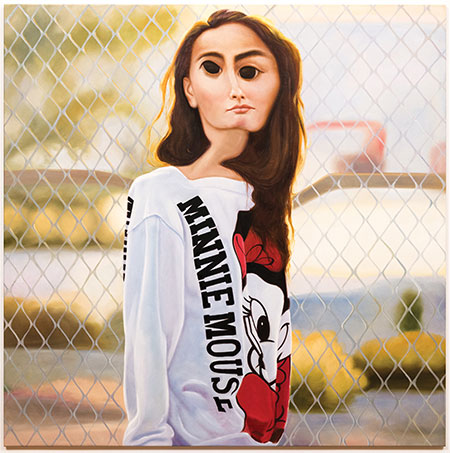
Amazing how some artwork can cause a critic to lose all sense of proportion. Frieze's Karen Archey went nuclear this month over Ryder Ripps' instagram paintings (for example, Mona Lisa, 2014, oil on canvas, above). Last year the New Museum-affiliated website Rhizome.org had some vaguely supportive things to say about the same body of work:
Instagram Corny-Core
Ryder Ripps is thinking about Instagram's "mawkishly sentimental tone to everyday common things," a heavily filtered, hypermoody selfie-lifestyle confluence. He takes Adrianne Ho's Instagram account as its apotheosis, and it's no coincidence that Ho's is a sponsored feed, tied to the clothes she's given to model.I've been aware of a profusion of variously branded content on Instagram for a while now, a result of friends working in the lifestyle publishing world — food, in particular, is a good way to see how this, pardon the pun, sausage is made. Brand diffusion on Instagram takes different forms. There is that which is obviously sponsored, as in paid (to the social network) ads that pop into feeds, or clearly demarcated sponsored 'editorial content' with brand @ing on 'independent' accounts. There is also a shadow economy of soft sponsorship by way of freebies then imaged by trusted native accounts. What Ryder is thinking about is what I see on a daily basis.
One reason that Instagram is so fertile for both styles of advertising is that its discoverability is so horrible — like its owner, Facebook, Instagram closes your feed in on itself, with very little invitation to explore different Instagram experiences, different Instagram worlds, different people. The Explore tab used to filter in all sorts of weird images that were trending, but as of late last year, it now displays things your friends are liking. Vine — wonderful, amazing Vine — in contrast, is all about discoverability, randomness, and blur... [emphasis added]
In her Frieze review [sign-in required], Karen Archey doesn't think that Adrianne Ho's Instagram is a form of commercial debasement, but states, rather, that the model's use of her body gives her "power." Instead of a comment on Instagram "sausage-making," she sees Ripps' work as simple misogyny:
In one painting, [the model's] nose becomes bulbous to the point of disfiguration (Nose Reflection, all works 2014); in another, her face is compressed into an alien-like arrangement (Mona Lisa); an additional work shrinks her waist to a spine’s width (Hourglass). This, of course, is a pointed thing to do to an image of a woman whose power hinges on her body’s appearance and her control over it.
The affront to Adrianne Ho is so extreme, Archey believes, that these paintings deserve to be "censured":
Some male artists, curators and writers seem to think that if they put something that is inadvertently misogynist into the world with purportedly good intentions, they shouldn’t be publicly censured in the name of free speech. If they feel that women demanding to be treated with respect tramples on their rights, maybe privilege has become so entrenched with identity that it has become blinding.
Well, is it inadvertent or not? No sense in asking -- by the end of her review, Archey's outrage has mounted to the point that she might as well be writing in capslock:
The most upsetting aspect of this situation is that a male artist was afforded the opportunity to mount such a misogynistic exhibition at a highly respected Manhattan gallery.
Here's hoping Archey never sees a George Condo show (which happen with some regularity in highly respected Manhattan galleries) -- she's going to be even more upset. Her Ripps review cribs arguments from Paddy Johnson's writings, which were already set at "10" on the bluster scale, and dials them up to "11." Is this necessary? You wonder if they even edit at Frieze, or if they just convert the capitals to lower case and send a thank-you email to the writer.
